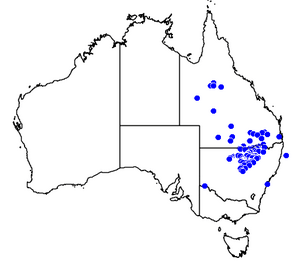Mud adder facts for kids
Quick facts for kids Mud adder |
|
|---|---|
 |
|
| Distribution of Denisonia devisi in Australia. Note the observation in far North-West Victoria | |
| Conservation status | |
| Scientific classification | |
| Genus: |
Denisonia
|
| Species: |
devisi
|
| Synonyms | |
|
|
The mud adder (Denisonia devisi ), also known as De Vis's banded snake, is a species of venomous snake in the family Elapidae. The species is endemic to certain regions of eastern Australia, including South West Queensland, northern New South Wales and north-west Victoria. Its scientific and common names refer to Charles Walter De Vis (1829-1915), first director of the Queensland Museum and writer of around 50 papers on herpetology.
Description
Denisonia devisi is short, thick, and slightly flat. The eyes are set at the top of the head and have a conspicuous iris. The dorsal surface of the body is yellowish-brown to olive-green in colour, broken by irregular, ragged-edged, narrow, dark bands running across the body. De Vis's banded snake is sometimes confused with death adders, as both have thick, banded bodies. The main difference is that the De Vis's banded snake's tail does not taper abruptly and its head is not broad and triangular.
Distribution and habitat
The De Vis's banded snake was thought to be confined to alluvial flats in Queensland and New South Wales. However, when mammal expert Peter Menkhorst reported a death adder in north west Victoria, an expedition was carried out in November 2005 to survey the Wallpolla Islands. Instead of finding a death adder, the survey identified a De Vis' banded snake for the first time in Victoria. Further confirmation of the species' new habitat came with a report on the results of raising water levels for environmental purposes at several sites along the Murray River at the Victoria - New South Wales border, making special note of the snake. The snake was found in Wallpolla Island Park, a 9,800 hectares (24,000 acres) area consisting of floodplain vegetation in the extreme North West, on the Victoria-New South Wales border. It was a designated “Icon Site”, an area of high ecological value within the Murray-Darling basin. The new addition to Victorian snakes was probably carried south during a period of flooding in the Murray River. The usually dry habitat had become more suitable over the years as water and biodiversity increased due to environmental water. Caution is recommended regarding potentially threatening landuse.
Behaviour
The mud adder is a sluggish snake inhabiting low-lying areas, particularly near sites subjected to seasonal flooding. During the day, this snake stays in the soil cracks or deep cavities and emerges at night to feed on frogs.
Reproduction
The mud adder gives birth to fully formed young with an average total length (including tail) of 11 cm (4.3 in). A litter consists of three to 11, five on average, baby snakes.
Taxonomy
This species was first described by De Vis in 1884 as Hoplocephalus ornatus. In 1920 Waite and Longman decided to place it in the genus Denisonia. However, since Krefft in 1869 had named a different species Denisonia ornata, the name was preoccupied. Therefore, Waite and Longman solved the conflict by creating the new name Denisonia maculata var. devisi. Subsequently, Cogger in 1983 raised it to full species status as Denisonia devisi.
- Waite ER, Longman AH (1920). "Descriptions of Little-known Australian Snakes". Records of the South Australian Museum 1 (3): 173-180. (Denisonia maculata var. devisi, new name, pp. 178–179).
See also
 In Spanish: Denisonia devisi para niños
In Spanish: Denisonia devisi para niños


